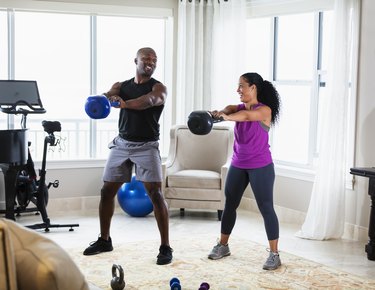

Love working out with kettlebells so much that it makes you want to break out into a dance? Well, that's essentially what a kettlebell flow is.
Kettlebell flows allow you to move seamlessly from one exercise to the next without any pause in between — almost like a dance. For example, you can do a single-arm kettlebell row to a deadlift to a swing clean.
Video of the Day
They generally combine three or more exercises and work different muscle groups at once. By avoiding any pauses and breaks in between, the dynamic nature of kettlebells gets your heart rate soaring while improving your coordination, mobility and stability.
And because you can combine unilateral (one-sided) with two-handed movements, you challenge your muscles in new ways. It also helps you hone in on your form, making sure each rep sets you up perfectly for the next move.
Ready to get swinging? Here's a total-body beginner kettlebell flow to help you get started. You'll need a 10 to 16 kg (22 to 35.2 pounds) kettlebell. Do each exercise for 5 to 10 reps before moving on to the next move in the flow. Aim to do 2 to 3 rounds of the entire kettlebell flow for beginners.
Check out more of our 20-minute workouts here – we've got something for everyone.
Move 1: High Plank Slides
- Start in a high plank with your shoulders directly over your wrists and your entire body in a straight line. Place a kettlebell outside of your right shoulder on the floor.
- While maintaining a high plank, lift your left hand off the floor and use it to pull the kettlebell to the left side.
- Continue to alternate sides for 5 to 10 reps, making sure your core is braced and your hips stay square throughout the movement.
- On the last rep, slide the kettlebell to the middle of your body, right under your chest.
Move 2: Frogger to Squat
- From a high plank position, jump your feet to the outsides of your hands and get into a squat.
- Bend your knees and push your hips back, lowering down until your thighs are parallel to the floor (or as low as you can comfortably go).
- Return to the starting position by placing your hands outside of your feet on the ground and jumping your feet back behind you.
- Do 5 to 10 reps.
Move 3: Two-Handed High Pull
- From the squat position in the previous move, hinge forward to grab the horn of the kettlebell with both hands. The kettlebell should be between the arches of your feet.
- Bracing your core, use the power from your legs and hips to explosively pull the kettlebell to shoulder height, elbows pointing toward the ceiling as you pull. Make sure to keep the kettlebell close to your body.
- Lower the kettlebell down between your legs, just above your knees, and repeat.
- Do 5 to 10 reps.
Move 4: Goblet Squat
- From the high pull, hold the kettlebell on the sides of its horns by your chest. Your elbows should be tucked by your ribs and pointing down and your feet shoulder-width apart.
- Bracing your core, bend your knees and push your hips back to lower down into a squat. Make sure the kettlebell isn't resting on your chest and that you're holding it in front of your chest.
- Drive through your heels to stand back up and return to the starting position.
Move 5: Overhead Press
- From the goblet squat position, hold the kettlebell by your chest with both hands.
- Bracing your core, press the kettlebell overhead, finishing with your biceps by your ears.
- Lower the kettlebell back down by your chest and repeat.
- Do 5 to 10 reps.
Move 6: Kettlebell Swing
- From the overhead position, bring the kettlebell down in a pendulum motion through your legs.
- Hinge your hips back and hold the kettlebell with both hands using a loose grip.
- Pushing your butt back and keeping your back flat, hike the kettlebell between your legs.
- As you straighten your legs to stand, use power from your hips to pull the kettlebell up to chest height.
- Using the bell's momentum, swing the weight back between your legs and under your hips as you simultaneously sink into your hips and bend your knees.
- Do 5 to 10 swings.
20-Minute Beginner Kettlebell Flow
Ready to put it all together? Watch below to see how to really get your flow on, fluidly cycling through all six exercises.